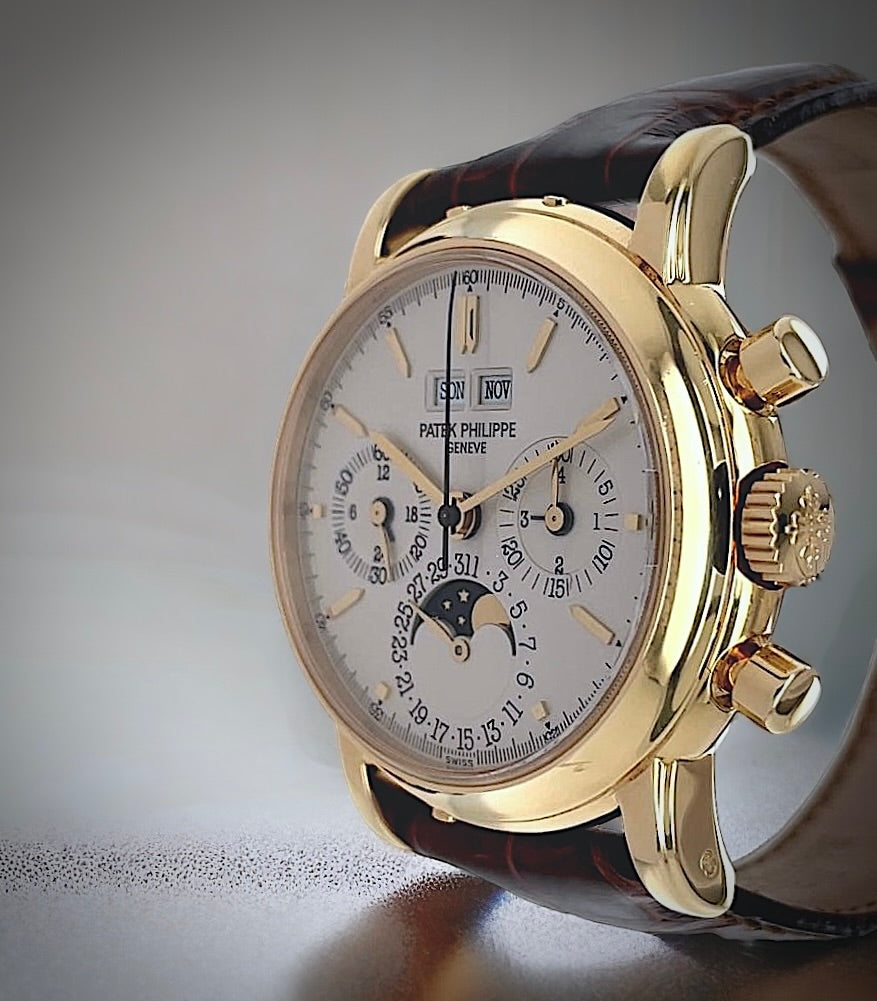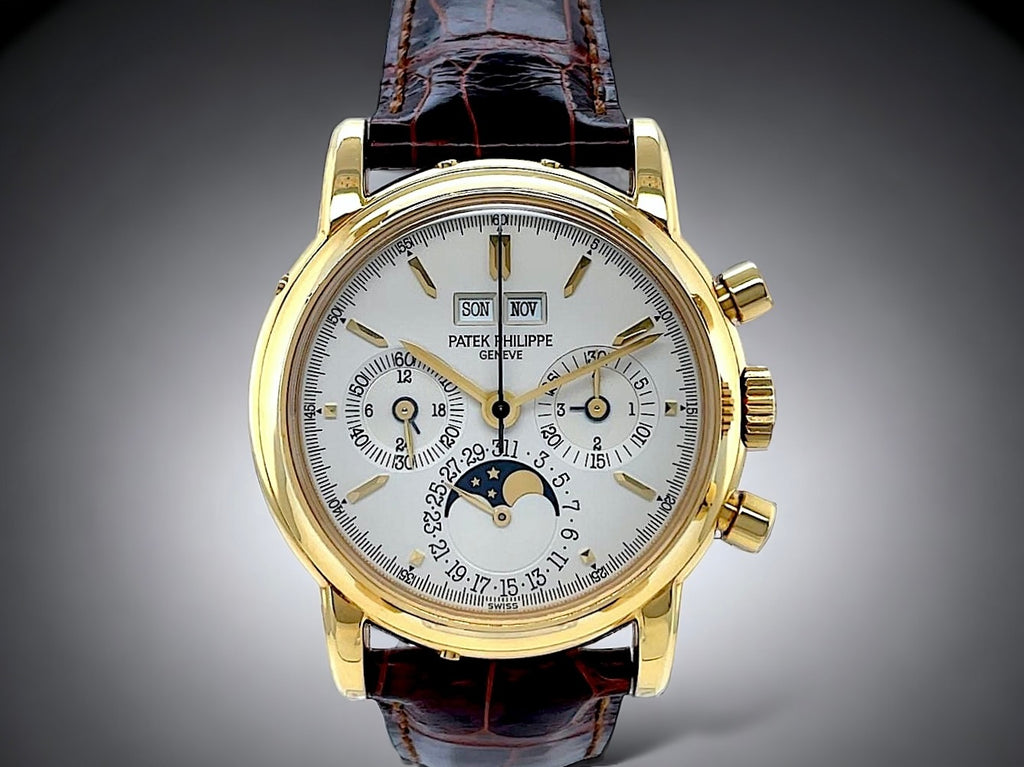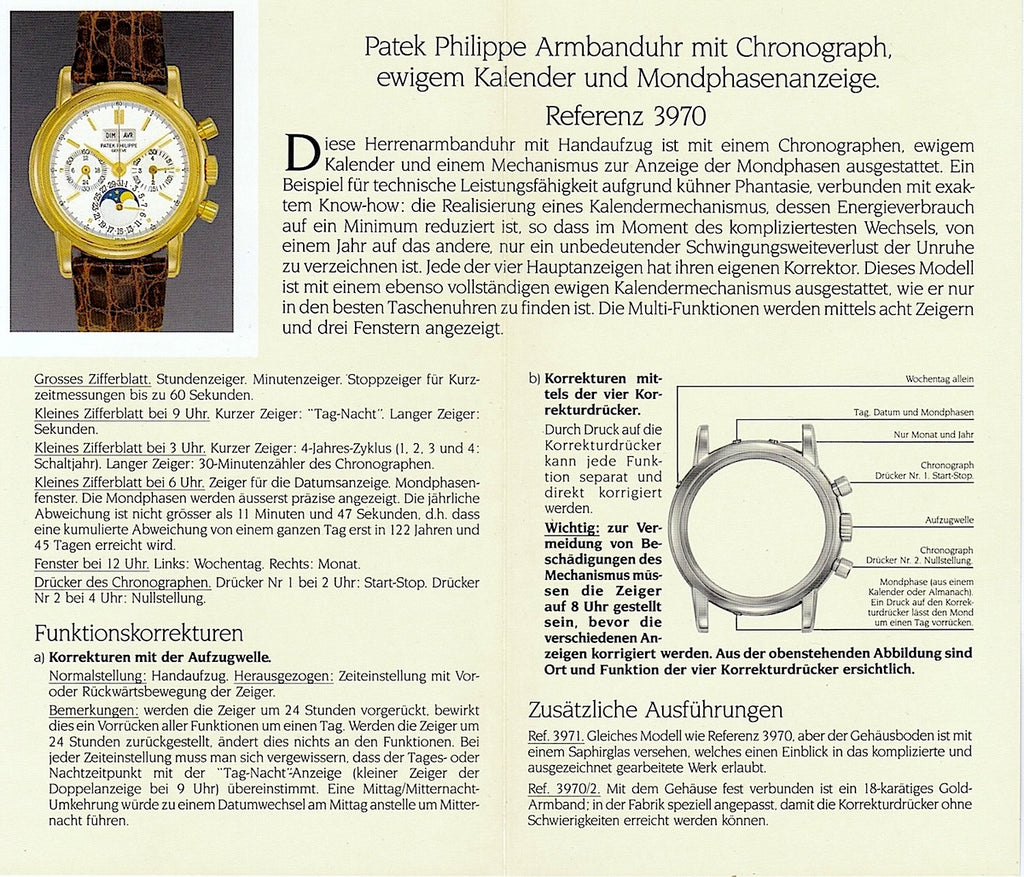Guide To The Patek Philippe Perpetual Calendar Chronograph 3970EJ

No watchmaker is as closely associated with perpetual calendar chronographs as Patek Philippe. While we may take it for granted today, combining a perpetual calendar with a chronograph in a wristwatch was no easy feat then — nor is it now. Patek Philippe introduced the first serially produced perpetual calendar chronograph wristwatch in 1941 with the reference 1518 and hasn’t stopped since.
While the brand has produced numerous models over the years, we’re taking a closer look at the Patek Philippe Perpetual 3970EJ, a reference that was once often overlooked by collectors but now gaining more appreciation in the market. Read on for our comprehensive guide to the Patek Philippe Perpetual Calendar Chronograph 3970EJ.
The Origins and Design of Reference 3970
The Patek Philippe Perpetual Calendar Chronograph 3970 was introduced in 1986 and it replaced the long-running reference 2499. An important factor to understand with reference 3970 is that Patek Philippe released it during an era when mechanical watches were losing popularity (thanks to the quartz revolution), and that was especially true of mechanical complicated watches. However, regardless of market conditions, Patek Philippe went ahead with producing what it was best at doing.
Patek opted to make the 3970 smaller than its predecessor, 36mm in diameter compared to the ref. 2499’s 37.5mm size. To accommodate the complications, the case is about 13.5mm thick, offering plenty of presence on the wrist despite its compact diameter.

Patek Philippe Perpetual Calendar Chronograph 3970EJ
The dial layout of the reference 3970 is very traditional for a Patek perpetual calendar chronograph; it includes a pair of apertures at the top for day and month, a 30-minute chronograph counter at 3 o’clock with a leap year indicator, a moonphase and date display at 6 o’clock, and a 12-hour chronograph counter at 9 o’clock with running seconds.
Powering the Perpetual Calendar Chronograph ref. 3970 is Caliber CH 27-70 Q, which was the first time Patek did not use a Valjoux-based movement for one of its chronographs. Instead, the brand used a Lemania 2310 base, modified it, and fitted it with Patek’s perpetual calendar module. Caliber CH 27-70 Q is a hand-wound movement that operates at 18,000 beats per hour and supplies the watch with 60 hours of power reserve.

Brochure of the Patek Philippe 3970 - Technical Data of the Movement
The 3970 was not only available in yellow gold, white gold, rose gold, and platinum but there are also four distinct series of the reference to know about.
The Four Series of Reference 3970
Patek Philippe produced the Reference 3970 from 1986 until 2004, and during that manufacturing run, there were some notable variations made. The variations can be classified into four series of the reference 3970.
First Series: 1986
The first series of Patek Philippe ref. 3970 comprises the first 100 examples that left the factory, all of which were made in 1986. This generation is characterized by a silvered dial, leaf hands, stick hour markers, and subtly off-color counters. Furthermore, the first series of Patek Philippe 3970 watches were all made in yellow gold and came fitted with solid snap-on casebacks.
Second Series: 1987-1990
A notable update to the second series of the Patek Philippe ref. 3970 was the inclusion of a solid screw-down caseback, which transformed the reference from 3970 to 3970E where “E” stands for étanche, which is French for waterproof (to 30 meters, in this case).
Furthermore, Patek added more material options to the mix; second series 3970E watches were available in yellow gold, white gold, rose gold, and platinum. Dial-wise, a subtle update was added whereby the subdials were now the same color as the main dial but the leaf hands and stick hour markers remained.
Third Series: 1990-1995
For the third series of the Perpetual Calendar Chronograph ref. 3970E, Patek decided to supply the watch with both solid and sapphire crystal casebacks, both screw-down. Again, all four precious metals were offered – yellow gold, white gold, rose gold, and platinum.
The dial underwent an update too. Baton hands replaced the leaf hands and pointed and faceted baton hour makers replaced the stick indices. Plus, the dial was now made in brighter silver, allowing the indications to contrast better against their background.
A detail worth mentioning is the evolution of the font used on the dial within the same third series; early models generally had serif fonts in the twin windows while later examples had larger san-serif fonts.
Fourth Series: 1995-2004
The fourth series of the Patek Philippe Perpetual Calendar Chronograph ref. 3970E looked exactly the same as the third series and was available in the same four metals.
However, Patek furnished the watch straps with a deployant clasp rather than a pin buckle and used a new serial number range.
Patek Philippe Perpetual Calendar Chronograph 3970EJ Third Series
Twain Time is proud to offer a third-series Patek Philippe Perpetual Calendar Chronograph ref. 3970EJ. The “J” in the reference number refers to its yellow gold case; “jaune” in French.
Made in 1992, this Patek Philippe Perpetual Calendar Chronograph ref. 3970EJ sports a 36m yellow gold case, furnished with a pair of chronograph pump pushers flanking the winding crown. Of course, that crown is embellished with Patek’s emblematic Calatrava Cross. As is customary for the reference, the bezel is concave, the case flank is bulbous, and the lugs are stepped. Protecting the dial is scratch-resistant sapphire crystal.

Patek Philippe 3970EJ 3rd Series - Crown and Chronograph Pushers Detail
As part of the third series, this Patek Philippe Perpetual Calendar Chronograph ref. 3970EJ features a bright silver dial punctuated with gold baton hands at the center. The indexes are faceted and pointed, also crafted in matching yellow gold. Since this is an earlier example from the third series, the font inside the day and month windows are serif fonts.

Patek Philippe 3970EJ 3rd Series - Dial Detail
The watch is paired with a brown alligator strap, which is fitted with a yellow gold pin buckle. The solid gold screw-down caseback shields the manual-winding Caliber CH 27-70 Q manual-winding movement inside the watch. While the accompanying sapphire caseback is no longer part of the set, the set does include the Certificate of Authenticity (with leather booklet and manual) , the extract from the Patek Philippe archives, and the original Patek Philippe presentation box.

Patek Philippe 3970EJ 3rd Series - The Set
An absolute classic Patek Philippe Grand Complication, the Perpetual Calendar ref. Perpetual Calendar Chronograph ref. 3970EJ illustrates Patek Philippe's mastery of creating enduring and iconic timepieces.
How To Use The Patek Philippe Perpetual Calendar Chronograph 3970EJ
A big draw of a perpetual calendar watch is that once it’s set, it no longer requires regular adjustments to accommodate varying month lengths or leap years (as long as it keeps running). The moon phase display only requires adjusting once every 122 years while the calendar windows will only need to be adjusted in the year 2100 when the leap year will be skipped. Essentially, it will remain perpetually correct during your lifetime.

Brochure of the Patek Philippe 3970 - Instructions
How To Wind the Watch
The winding crown is used to manually wind the watch (position 1) and to set the time (position 2)
Turn the crown clockwise gently and steadily, and stop when you feel resistance
It is recommended to wind the watch at about the same time every day, preferably morning
How to Set the Watch
The order of operations is very important when setting the watch. The calendar corrections must be performed in the following order:
- Move the hands to 6 a.m. (to move out of the “red zone”)
- To move the hands, pull the crown out to position 2
- Set the date to the first day of the month
- To set the date, actuate the correction push-piece between 11 and 12 o’clock as many times as needed to display the current date. Use the accompanying stylus.
- Correct the month and the leap-year cycle
- To simultaneously set the month and leap-year cycle, press the correction push-piece between 12 and 1 o’clock as many times as needed to display the current month and the current year (4 = leap year; 1 = 1st year after leap year; 2 = 2nd year after leap year; 3 = 3rd year after leap year).
- Correct the date
- Correct the day of the week
- To set the day of the week, press the correction push-piece between 10 and 11 o’clock as many times as needed to display the current day. Use the accompanying stylus.
- Correct the moon phase
- To set the correct moon phase, press the correction push-piece between 6 and 7 o’clock until the full moon appears. Then press the same push-piece as many times as the number of days that have elapsed since the last full moon. Consult an almanac to determine the number of days that have elapsed since the last full moon relative to the current date. Use the accompanying stylus.
- Set the time